The 1994 dime was issued about 30 years ago. It is part of the Roosevelt dime series that the US Mint started to strike starting in 1946. The Roosevelt dime is one of the most minted US coins and it has endured the test of time.
Continue reading below to learn more about the historical milestone, design, composition, and value of the 1994 Roosevelt dime.
What Is the 1994 Roosevelt Dime Made Of?
The US Mint started producing the Roosevelt Dime in 1946. At that time, the dime was made of 90% silver and 10% copper. However, by 1965, the US Mint transitioned to using base metal and essentially removing silver from standard-struck US coins. This also affected the Roosevelt Dime.
Thus, the 1994 Roosevelt dime was made of copper and nickel instead of silver. Specifically, the 1994 Roosevelt dime was made of 75% copper (Cu) and 25% nickel (ni). The dime has a core of copper while it is covered with nickel.
Franklin Roosevelt (FDR) was the president who led the nation through the Great Depression and World War II. He was also the one who helped in starting the March of Dimes organization, which helps people with disabilities and improves people’s health.
Because of the great positive impact of FDR on the country, the nation honored him by immortalizing him through the 10-cent coin.
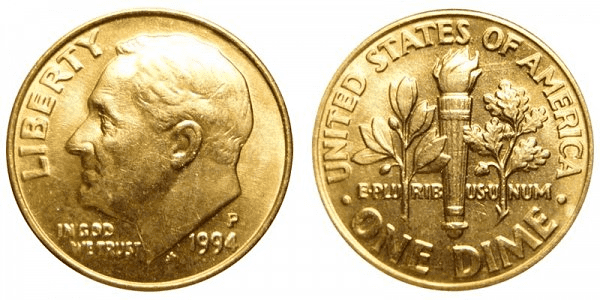
With this in mind, on May 17, 1945, the Treasury Secretary at that time announced that the Roosevelt dime would replace the winged Liberty dime. He would be the fourth president who would be added to a US coin along with Washington, Jefferson, and Lincoln.
The Chief Engraver, John Sinnock, was tasked to create the new dime design. The final design was chosen, which is the same design used until this day.
The obverse design includes the image of Franklin Roosevelt, facing to the left. Inscriptions include LIBERTY, IN GOD WE TRUST, 1994, mint mark, and JS (designer’s initial).
The reverse design includes sprigs of olive and oak. Between them is the Liberty torch, which symbolizes enlightenment.
1994 Roosevelt Dime Varieties
There were four official varieties of the Roosevelt dime in 1994. Here’s a quick look at them:
| Variety | Mint Location | Mintage |
| 1994 D Mercury Dime | Denver | 1,303,268,110 |
| 1992 P Mercury Dime | Philadelphia | 1,189,000,000 |
| 1992 S Proof Mercury Dime | San Francisco | 2,484,594 |
| 1992 S Proof Silver Mercury Dime | San Francisco | 785,329 |
| Total | 2,495,538,033 |
Let us now take a deeper look at each of these varieties.
1994 D Mercury Dime
Year of minting: 1994
Mint Mark: D
Place of minting: Denver
Quantity produced: 1,303,268,110
Face Value: $0.10 (10 cents)
Price: $0.15 to $0.35 (circulated condition)
Mass: 2.27 grams
Edge: Reeded
Designer: John R. Sinnock
Composition: 75% copper and 25% nickel
Diameter: 17.90 millimeters
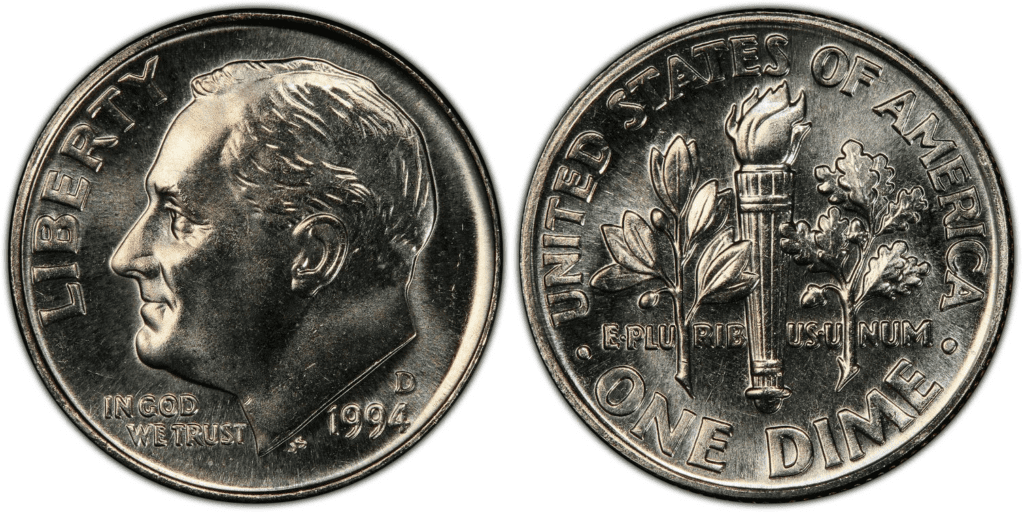
The Denver Mint produced the most number of 10-cent coins in 1994, releasing more than 1.3 billion of them. That’s a huge number, which only proves how much the dime has become so popular.
Buying a circulated 1994 D dime may cost you around $0.15 to $0.35.
1994 P Mercury Dime
Year of minting: 1994
Mint Mark: P
Place of minting: Philadelphia
Quantity produced: 1,189,000,000
Face Value: $0.10 (10 cents)
Price: $0.15 to $0.35 (circulated condition)
Mass: 2.27 grams
Edge: Reeded
Designer: John R. Sinnock
Composition: 75% copper and 25% nickel
Diameter: 17.90 millimeters
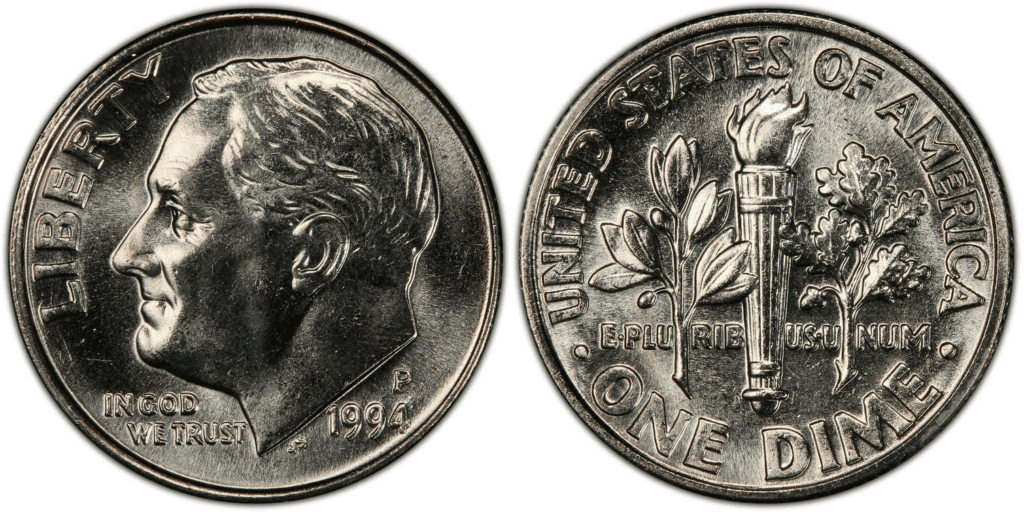
The Philadelphia Mint exceeded the one-billion mark of mintage figure for the Roosevelt dime in 1994. Because of the massive number of the 1994 P dime, its value is low.
1994 S Proof Mercury Dime
Year of minting: 1994
Mint Mark: S
Place of minting: San Francisco
Quantity produced: 2,484,594
Face Value: $0.10 (10 cents)
Price: $5.70 or more (uncirculated condition)
Mass: 2.27 grams
Edge: Reeded
Designer: John R. Sinnock
Composition: 75% copper and 25% nickel
Diameter: 17.90 millimeters
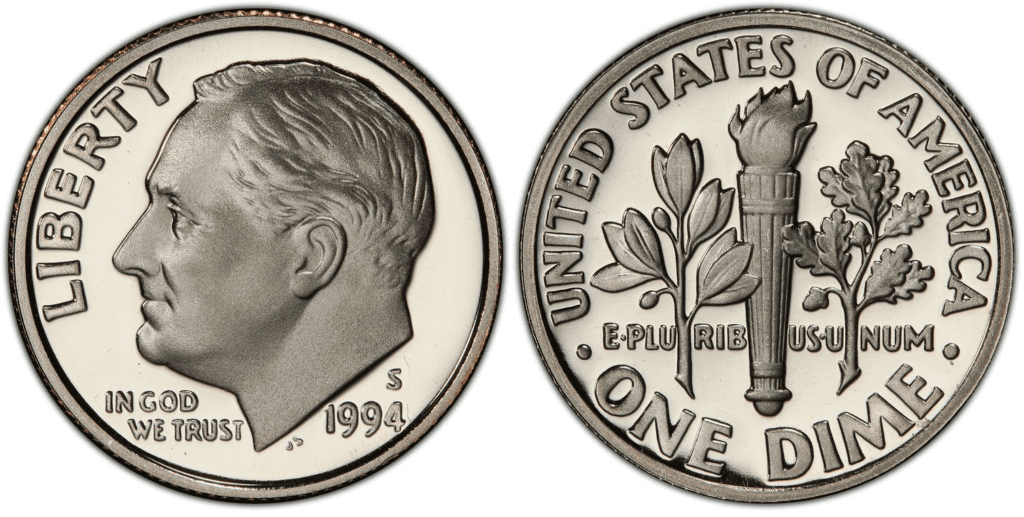
The San Francisco Mint produced more than 2.4 million proof coins in 1994. This is slightly lower than the mintage figure in 1993. Nevertheless, it is still an impressive number. This shows you that even proof coins are in great demand.
The 1994 S-proof coins may cost around $5.70.
1994 S Silver Proof Mercury Dime
Year of minting: 1994
Mint Mark: S
Place of minting: San Francisco
Quantity produced: 785,329
Face Value: $0.10 (10 cents)
Price: $9.67 or more (uncirculated condition)
Mass: 2.27 grams
Edge: Reeded
Designer: John R. Sinnock
Composition: 75% copper and 25% nickel
Diameter: 17.90 millimeters
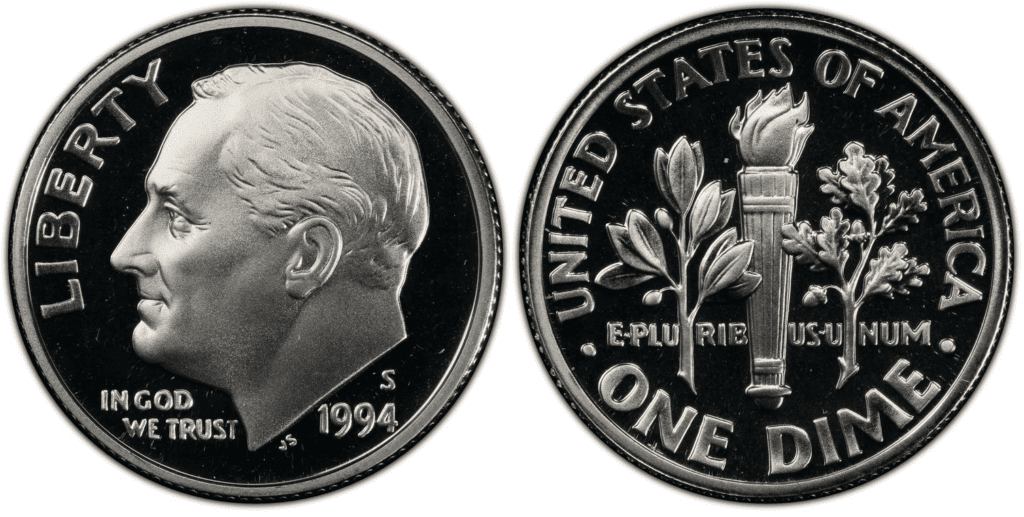
Aside from the standard proof coins, the San Francisco Mint also produced a silver version of its proof coins. Since it has precious metal in it, the 1994 S silver dime is more valuable than its 1994 dime counterparts.
The San Francisco Mint issued more S silver dimes in 1994 compared to the previous year.
List Of 1994 Roosevelt Dime Errors
The US Mint produced almost 2.5 billion Roosevelt dimes in 1994. This will continue until 1996. Now, that’s a huge number and with a number like this, you’ll be certain that some coins will create some form of error.
Errors may be caused by mechanical or human error. Some errors may happen during a strike while others happen when the planchet was being produced.
While the US Mint might not like to have error coins, numismatists are highly interested in them. Thus, if ever you find a 1994 error dime in your pocket, don’t throw it away. It could be worth a few hundred dollars.
Here are some examples of 1994 dime errors:
Strike through error
The strike through error happens when a foreign object got stuck between the planchet and the die. Because of this, the die strikes through the foreign object, rendering the strike to be less effective.
There are different things that could happen during a strike through error. However, the common result is that there would be missing elements on the coin.
Here’s an example:
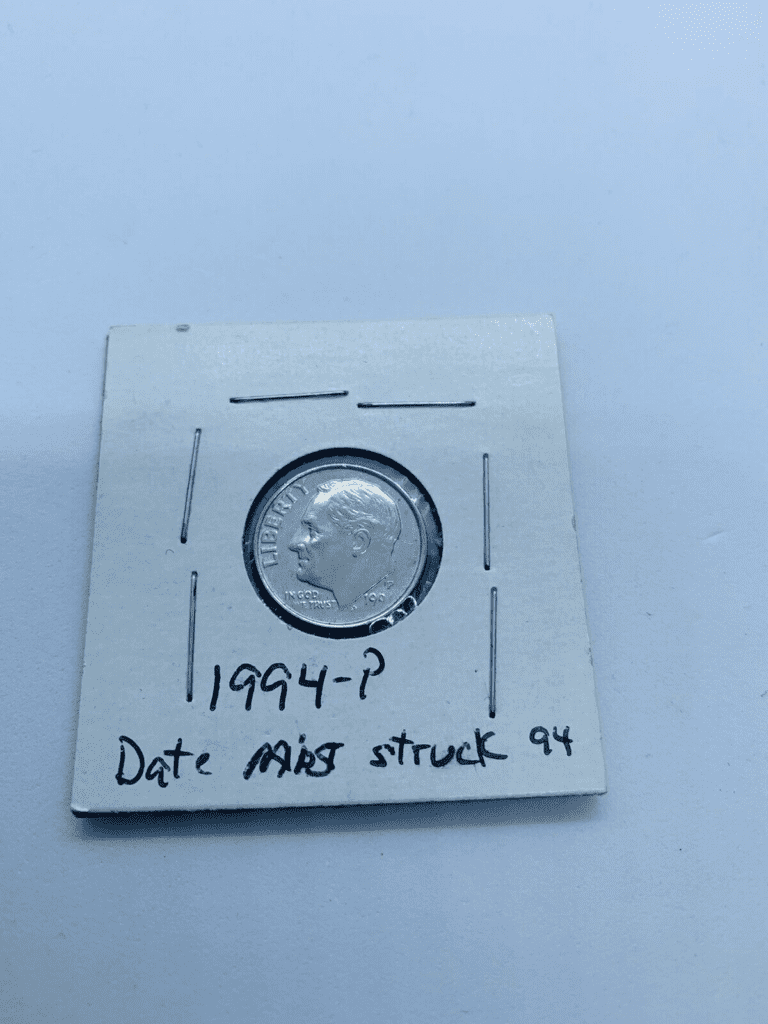
Look at the year, “1994.” The number four is missing.
Off-center strike
The planchet should be properly aligned to the die so that all the engraved elements are fully added to the blank coin. However, due to a mechanical error, the planchet isn’t placed at the right angle. As a result, an off-center strike happens.
Here’s an example:
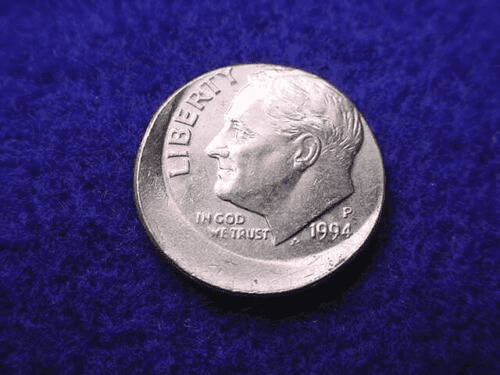
Doubled die error
There are times when the die was so fast in striking the coin and the coin is still in the punching area. Because of this, the coin was struck twice. Normally, a double strike won’t cause any problems. However, if the second strike hits the coin in even a slightly different angle, a doubled die error could happen.
There are two types of doubled die error, the doubled die obverse (DDO) and doubled die reverse (DDR). They differ depending on which side of the coin received the error.
If the doubled die error is so prominent, the coin could be sold for hundreds of dollars.
How Much Is 1994 Roosevelt Dime Worth Today?
If you base the value of the Roosevelt dime on its face value or melt value, you won’t get a lot from it. For example, the face value of the 1994 Roosevelt dime is only 10 cents. Its melt value is $0.0240. However, the silver-proof coin variant has a higher melt value, which is $1.6182.
According to NGC, a circulated 1994 Roosevelt dime can be just around $0.15 to $0.35.
Nevertheless, there are still 1994 Roosevelt dimes that are worth a lot of money. To fully appreciate its value, here’s a 1994 dime values chart featuring the auction records of each variety:
| Coin | Condition | Grade | Sold date | Sold by | Value |
| 1994 D Roosevelt Dime | Superb Gem Uncirculated – Full Band
|
MS 68 | December 9, 2020 | Heritage Auctions | $1,680 |
| 1994 P Roosevelt Dime | Superb Gem Uncirculated – Full Band | MS 68 | October 18, 2020 | Heritage Auctions | $1,080 |
| 1994 S Silver Proof Roosevelt Dime | Perfect Uncirculated – Deep Cameo | PR 70 | October 7, 2003 | Heritage Auctions | $719 |
| 1994 S Proof Roosevelt Dime | Perfect Uncirculated – Deep Cameo | PR 70 | November 25, 2003 | Heritage Auctions | $495 |
If you have error coins with unique and rare attributes, it could also be sold more than its face value and melt value.
How Does The Grading System Work?
The Roosevelt dime is graded based on the Sheldon Scale, which is a 70-point grading system used by appraisers to assess the condition of a coin. Your 1994 dime would be assessed based on its attractiveness, strike, and level of preservation.
Aside from the numerical grade, a coin would also be categorized as Mint State (MS) or Proof (PR). MS is given to coins that were originally made for circulation. PR is given to coins that were originally made for collectors.
The 1994 dime would also be given an adjective as part of its grading. Depending on the coin’s Sheldon Scale score, it could be categorized as Poor, Good, Fine, Uncirculated, and Circulated, just to name a few.
Moreover, the Roosevelt dime can also be called Full Band or not. Full Band dimes are those coins with prominent or detailed horizontal twin bands on the torch.
Professional numismatists joined together in the 1970s and established CoinGrading standards. These numismatists now assign grades at key places on the seventy-point scale, using the most regularly utilized numeric points in conjunction with the original adjective grade. The following are the most common coin grades:
-
-
- (P-1) Poor – Indistinguishable and probably damaged; if used, must have a date and mintmark; otherwise, rather battered.
- (FR-2) Fair – Nearly smooth, but without the damage that a coin graded Poor often possesses. The coin must have enough detail to be identified.
- (G-4) Fair – Inscriptions have merged into the rims in some areas, and important elements have been mostly erased.
- (VG-8) Very Good- A little weathered, but all of the primary design elements are visible, albeit faintly. There is little if any, central detail left.
- (F-12) Good – The item is very worn, yet the wear is even, and the overall design details stand out clearly. Rims are almost completely isolated from the field.
- (VF-20) Very Fine – Moderately weathered, with some finer features still visible. The motto or all letters of LIBERTY are readable. Both sides of the coin have entire rims that are separated from the field.
- (EF-40) Extremely Fine – Gently used; all gadgets are visible, and the most important ones are bold. The finer details are bold and clear, however, light wear may be seen.
- (AU-50) Uncirculated – Slight evidence of wear on the coin’s design’s high points; may have contact marks; eye appeal should be adequate.
- (AU-58) Uncirculated Choice – Slight traces of wear, no severe contact marks, almost full mint shine, and great eye appeal.
- (MS-60) Mint State Basal – Strictly uncirculated; no indication of wear on the coin’s highest points, but an unsightly coin with reduced luster, visible contact marks, hairlines, and other flaws.
- (MS-63) Mint State Acceptable – Uncirculated, but with contact scratches and nicks, little reduced shine, but otherwise appealing appearance. The strike is weak to average.
- (MS-65) Mint State Choice – Uncirculated with great mint shine, very little contact blemishes, and exceptional eye appeal. The strike is unusually severe.
- (MS-68) Mint State Premium Quality – Uncirculated with superb luster, no obvious contact marks to the naked eye, and exceptional eye appeal. The strike is quick and appealing.
- (MS-69) Almost Perfect Mint State – Uncirculated with perfect brilliance, a sharp and appealing strike, and extremely good eye appeal. A near-perfect coin with minor imperfections in the planchet, strike, and contact markings (seen only under 8x magnification).
- (MS-70) Mint State Perfect – Under 8x magnification, there are no tiny imperfections discernible; the strike is crisp, and the coin is perfectly centered on a beautiful planchet. Rarely seen on a coin, this coin is bright and whole, with original luster and exceptional eye appeal.
-
Where To Buy Or Sell 1994 Roosevelt Dime?
The Roosevelt dime issued in 1994 can be bought on the Internet. You can do a quick search on Google and you should receive tens of relevant websites.
You can also head to Amazon, eBay, or Etsy since these websites allow you to both buy and sell 1994 Roosevelt dimes. You can try social media platforms and post your needs or your coin.
Aside from the Internet, coin shops, pawnshops, and antique stores may help. You can also get in touch with professional grading services providers such as PCGS and NGC. They could point you in the right direction when it comes to buying or selling 1994 Roosevelt dimes.
FAQs
How much does a 1994 dime weigh?
All 1994 dime varieties weigh 2.27 grams except for the silver variant which is 2.50 grams.
Is there anything special about a 1994 dime?
There’s nothing special about the 1994 dime. However, it can easily become special if it was officially graded and it received a high grade. It can also be a special coin if it is an error coin with unique attributes.
What is a 1994 gold dime worth?
The 1994 dime is made of copper and nickel. There’s also a silver 1994 dime. However, there was no gold dime made in 1994. If you found a gold dime, that could possibly fetch a thousand dollars.
